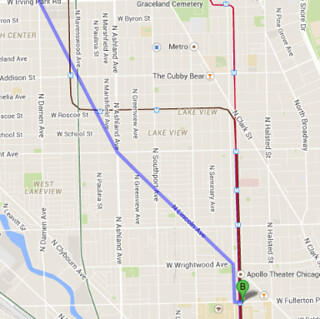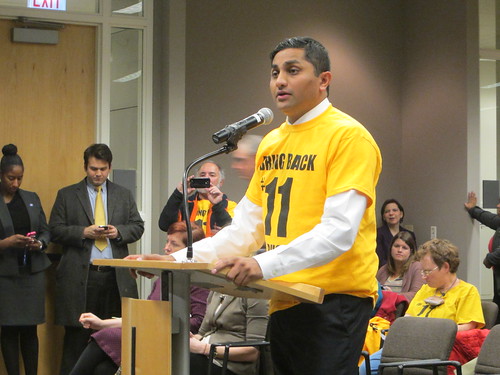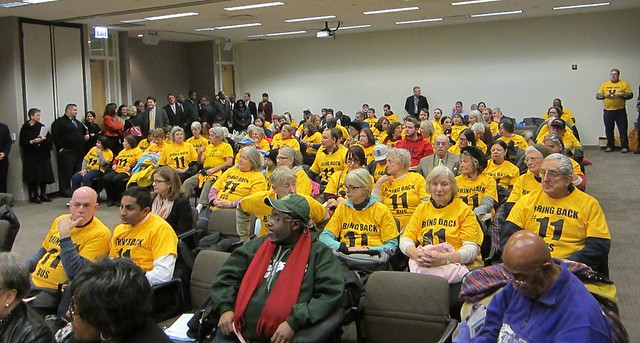Last night, local community leaders and dozens of senior citizens showed up for the CTA’s 2015 budget hearing, imploring the agency to restore the full #11 Lincoln Avenue bus route.
The Lincoln bus previously ran between Skokie and the Blue Line’s Clinton station in the West Loop. As part of the CTA’s 2012 decrowding plan, which added service to 48 bus routes and most ‘L’ lines, the agency partially or completely cut service on roughly a dozen bus routes. The heart of the Lincoln route, from the Brown Line’s Western stop to the Fullerton station, was eliminated as part of these cuts.
The #11 still travels between Skokie and Western, and a new #37 Sedgwick bus now runs between Fullerton and Clinton. However, the total bus ridership on Lincoln has dropped from the previous average of 5,489 rides per weekday to 3,152 rides, RedEye reported. Overall, CTA bus ridership has dropped over the past few years.
When the bus cuts were announced, the CTA stated that affected #11 riders could instead take the Brown Line, which roughly parallels Lincoln between Western and Fullerton. In the past two years, the CTA has added 15 weekday Brown Line roundtrips per day, and increased service on eight of the ten bus lines that serve the area, RedEye reported. The CTA says the Lincoln route cut is saving the agency $1.4 million a year.

However, some locations on this stretch of Lincoln are a half mile away from the nearest Brown Line station – a ten-minute walk for able-bodied people, and a significant distance for seniors and people with disabilities. The Brown Line was overhauled in the late Nineties, and all stops are currently ADA accessible. 47th Ward Alderman Ameya Pawar has said bus cut has increased travel times for his constituents. Some are now choosing to drive instead of taking transit, or are avoiding destinations on Lincoln, he said.
The CTA has said it doesn’t plan to bring the Lincoln service back, arguing that the affected area is still one of the most transit rich parts of the city. Pawar has offered to use Tax Increment Financing money to help restore the service, but TIF funds can only be used for infrastructure, not operating expenses. Frustrated with the agency’s refusal to reverse their decision, the alderman has said he’s pulling his support for the Ashland bus rapid transit project.
Dozens of seniors rode with Pawar on chartered buses to the hearing at the CTA’s downtown headquarters. They wore yellow t-shirts that said “Bring back the #11 Bus” and “It’s our lifeline.”
At the start of the meeting, CTA President Forrest Claypool touted the agency’s achievements under the Emanuel administration. “After inheriting a $308 million deficit in 2011, this is our fourth consecutive balanced budget.” He noted that the $1.44 billion budget includes no fare hikes or service cuts, but will instead increase service slightly on the Orange and Blue Lines. Meanwhile, the agency will continue with its $5 billion infrastructure modernization program, Claypool said.
When the floor was opened to comments, state rep Greg Harris, whose 13th District includes an affected stretch of Lincoln, thanked Claypool for the CTA’s progress but noted that the #11 service cut has had unintended consequences. “I was walking in this bitter cold weather today, and I realized how hard it is for some folks to make it to a train line or a bus line on a good day,” he said. “But for someone who’s frail or someone who may have problems with mobility, it’s really very difficult.” He asked the agency to rethink its decision, and promised to help push for better transit funding in Springfield.
When Pawar took the mic, he said five different chambers of commerce and numerous community organizations have written letters to support restoring #11 service. He noted that over 2,500 constituents responded to a survey the ward conducted this summer, and 80 percent said the cut has led to longer travel times for their trips along Lincoln.
“What you have behind me are the faces of the cut,” Pawar said, indicating the crowd of seniors. “These are the people who are most dramatically impacted by the elimination of the #11 bus… Asking seniors, asking parents with strollers, asking folks with disabilities to walk four or five blocks to get on the Brown Line is just a non-starter for a lot of the people who are here tonight.”
“We’re all going to be seniors one day, and we hope that the system that we pay into… will also take care of us when we are seniors,” he concluded. “We want to create a city where people can age in place.”
Lindsay Eanet, associate director of the Northcenter of Chamber of Commerce reported that the service cut has hurt local businesses, from mom-and-pops to big box drugstores, and some have even had to close their doors. “We’ve actually received letters from community members who said that the lack of the Lincoln Avenue bus precluded them from buying property in our area,” she added.
One senior testified that she had recently had knee surgery, which makes it difficult to walk to the Brown Line. “I would have taken the #11 bus downtown today if I could have,” she said. “Now it’s easier to drive… Please let us help you come up with ways to pay for the #11 bus.”





